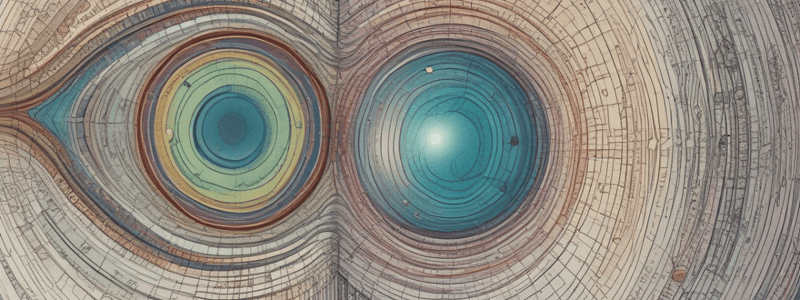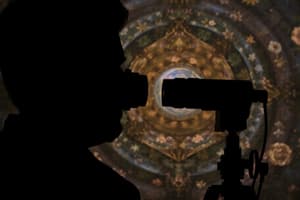Podcast
Questions and Answers
What condition may lead to the absence of the red reflex during an evaluation?
What condition may lead to the absence of the red reflex during an evaluation?
- Dense cataract (correct)
- Corneal abrasion
- Retinal detachment
- Optic neuritis
What technique is used by neuro-ophthalmologists to assess visual fields in selected patients?
What technique is used by neuro-ophthalmologists to assess visual fields in selected patients?
- Fundus autofluorescence
- Visual acuity testing
- Goldmann perimetry (correct)
- Visual field mapping
Which finding is assessed in the optic disc evaluation?
Which finding is assessed in the optic disc evaluation?
- Optic disc edema (correct)
- Retinal detachment signs
- Presence of defects in color vision
- Corneal clouding
What may be identified by taking red-free fundus photographs?
What may be identified by taking red-free fundus photographs?
The appearance of which structure is evaluated last during a comprehensive examination?
The appearance of which structure is evaluated last during a comprehensive examination?
What does autofluorescence photography help to map in the retinal pigment epithelium layer?
What does autofluorescence photography help to map in the retinal pigment epithelium layer?
What may be the difficulty encountered when examining the fundus with a direct ophthalmoscope?
What may be the difficulty encountered when examining the fundus with a direct ophthalmoscope?
Which ocular finding may appear in the peripapillary region during an evaluation?
Which ocular finding may appear in the peripapillary region during an evaluation?
What condition can lead to lipofuscin accumulation in retinal pigment epithelial cells?
What condition can lead to lipofuscin accumulation in retinal pigment epithelial cells?
What is the first step a clinician takes to assess the visual field?
What is the first step a clinician takes to assess the visual field?
During finger counting in the quadrants, how many quadrants does the clinician assess?
During finger counting in the quadrants, how many quadrants does the clinician assess?
What type of hemianopia is described as resulting from a lesion of the left optic tract?
What type of hemianopia is described as resulting from a lesion of the left optic tract?
What does simultaneous finger counting assess in the patient's visual field?
What does simultaneous finger counting assess in the patient's visual field?
Which part of the visual pathway is associated with right incongruous hemianopia?
Which part of the visual pathway is associated with right incongruous hemianopia?
What should the clinician do if the patient indicates an abnormality during testing?
What should the clinician do if the patient indicates an abnormality during testing?
What is the least common site for hemianopia according to the content provided?
What is the least common site for hemianopia according to the content provided?
What is assessed in the central 20 degrees of the visual field?
What is assessed in the central 20 degrees of the visual field?
Which visual deficit occurs due to a lesion of the inferior optic radiations?
Which visual deficit occurs due to a lesion of the inferior optic radiations?
Why does the visual field not expand with nonorganic visual field constriction?
Why does the visual field not expand with nonorganic visual field constriction?
What characteristic distinguishes incongruous hemianopia from other types of hemianopia?
What characteristic distinguishes incongruous hemianopia from other types of hemianopia?
Which of the following questions is NOT asked during the grid examination?
Which of the following questions is NOT asked during the grid examination?
Which of the following statements is true about the temporal retina?
Which of the following statements is true about the temporal retina?
What equipment is used for visual field assessment at a distance of 30 cm?
What equipment is used for visual field assessment at a distance of 30 cm?
Which anatomical structure is involved in the processing of visual information before reaching the visual cortex?
Which anatomical structure is involved in the processing of visual information before reaching the visual cortex?
What visual field defect results from a lesion affecting the right side of the visual pathway?
What visual field defect results from a lesion affecting the right side of the visual pathway?
What does visual inattention often indicate during confrontation testing?
What does visual inattention often indicate during confrontation testing?
Which term describes a condition where only the superior visual field of the left side is lost?
Which term describes a condition where only the superior visual field of the left side is lost?
What condition can cause sudden monocular visual loss without progression?
What condition can cause sudden monocular visual loss without progression?
Which of the following is a potential cause of progressive visual loss?
Which of the following is a potential cause of progressive visual loss?
Which factor is NOT commonly associated with transient binocular visual loss?
Which factor is NOT commonly associated with transient binocular visual loss?
Which of the following can cause sudden binocular visual loss without progression?
Which of the following can cause sudden binocular visual loss without progression?
In cases of hereditary optic neuropathies, which condition is specifically identified?
In cases of hereditary optic neuropathies, which condition is specifically identified?
Which condition is associated with transient visual obscurations?
Which condition is associated with transient visual obscurations?
Which of the following can lead to sudden monocular visual loss due to vascular issues?
Which of the following can lead to sudden monocular visual loss due to vascular issues?
What factor is commonly involved in the causes of transient monocular visual loss?
What factor is commonly involved in the causes of transient monocular visual loss?
Which mechanism can result in progressive visual loss involving inflammation?
Which mechanism can result in progressive visual loss involving inflammation?
What does the RNFL thickness map indicate in the optical coherence tomography analysis?
What does the RNFL thickness map indicate in the optical coherence tomography analysis?
In the context of optical coherence tomography, what does 'C/D ratio' refer to?
In the context of optical coherence tomography, what does 'C/D ratio' refer to?
What is the purpose of comparing RNFL thicknesses with age-matched normal controls?
What is the purpose of comparing RNFL thicknesses with age-matched normal controls?
What can be inferred if the RNFL thickness measurements fall within the normal range?
What can be inferred if the RNFL thickness measurements fall within the normal range?
Which component is NOT typically included in the optical coherence tomography analysis results?
Which component is NOT typically included in the optical coherence tomography analysis results?
What does the analysis of the neuro-retinal rim help to determine?
What does the analysis of the neuro-retinal rim help to determine?
What information can be derived from the quadrant measurements of RNFL thickness?
What information can be derived from the quadrant measurements of RNFL thickness?
For which eye measurement is 'OD' used in the optical coherence tomography context?
For which eye measurement is 'OD' used in the optical coherence tomography context?
What does the inferior quadrant measurement generally indicate in RNFL thickness analysis?
What does the inferior quadrant measurement generally indicate in RNFL thickness analysis?
Flashcards are hidden until you start studying
Study Notes
Visual Field Examination Steps
- Assess visual field constriction using nonorganic (functional) methods, involving occlusion of one eye while maintaining fixation on the clinician’s nose.
- Examine the central 20 degrees of each eye's visual field using the Amsler grid at a distance of 30 cm.
- Perform finger counting in each of the four quadrants to identify any visual field deficits.
- Conduct simultaneous finger counting with both hands in upper and lower quadrants to further assess visual attention.
- Evaluate for visual inattention during confrontation testing, encouraging patients to draw abnormal areas noted.
Ophthalmic Imaging Techniques
- Use optical coherence tomography (OCT) to analyze optic nerve head and retinal nerve fiber layer (RNFL) for abnormalities.
- Assess retinal vascular health with fundus photographs, particularly for conditions such as central retinal artery occlusion (CRAO) and diabetic retinopathy.
- Utilize fluorescein angiography for enhanced viewing of retinal vascular integrity following intravenous fluorescein injection.
- Employ fundus autofluorescence photography to evaluate lipofuscin accumulation, suggesting photoreceptor degradation.
Additional Evaluation Considerations
- Examine the optic disc for edema, pallor, and cupping, along with the peripapillary region for hemorrhages and exudates.
- Investigate macular condition located temporal to the optic disc for subtle retinal disease indicators.
Causes of Visual Loss
- Transient visual loss can result from retinal circulation emboli, migraines, or hypoperfusion conditions.
- Sudden bilateral visual loss may occur due to occipital lobe strokes or bilateral ischemic optic neuropathies.
- Progressive visual loss originates from anterior visual pathway inflammation (e.g., optic neuritis) or compression (e.g., tumors).
- Sudden monocular visual loss can be linked to retinal artery occlusions, anterior ischemic optic neuropathies, or traumatic optic neuropathy.
General Considerations
- Visual recovery from visual field deficits varies widely depending on the underlying etiology and individual mitochondrial DNA mutations.
- Clinical assessments should be thorough to avoid missing subtle presentations of visual field abnormalities.
Studying That Suits You
Use AI to generate personalized quizzes and flashcards to suit your learning preferences.




